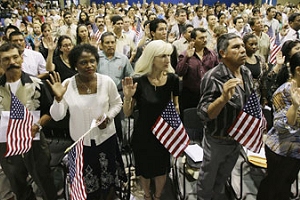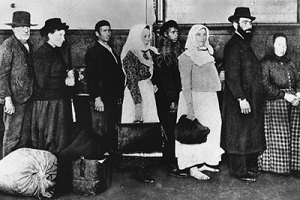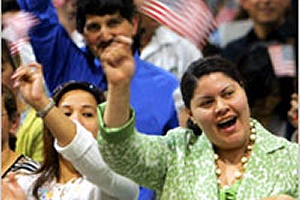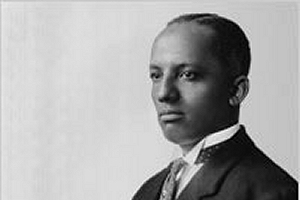America in context
American Identity: Ideas, Not Ethnicity

Since the United States was founded in the 18th century, Americans have defined themselves not by their racial, religious, and ethnic identity but by their common values and belief in individual freedom.
“I’m in a New York state of mind.” —Billy Joel
In 2000 35.9 percent of the people living in New York City were foreign born. —U.S. Census Bureau
In 1782, barely six years after the United States of America declared its nationhood, Benjamin Franklin offered certain “Information to Those Who Would Remove to America.” Among the constellation of outsized historical actors Americans came to know as their “founding fathers,” Franklin was in many ways the most typically American: If George Washington was inapproachably august, Thomas Jefferson bookish, and John Adams dour, it was Franklin — that practical inventor, resourceful businessman, and ever-busy civic catalyst — who best understood that his countrymen were, as the historian Walter McDougall would later call them, a nation of hustlers. In such a land, Franklin instructed the would-be immigrant:
People do not inquire concerning a Stranger, What is he? but, What can he do? If he has any useful Art, he is welcome; and if he exercises it, and behaves well, he will be respected by all that know him.
Franklin’s remark was grounded in first-hand observation: As early as 1750, German immigrants outnumbered English stock in his home colony of Pennsylvania. The newcomers were perceived as industrious and law-abiding. Skillful farmers, they improved the land and stimulated economic growth. In 1790, when Congress set the first national standard for naturalized citizenship, it required no ethnic or religious test, no literacy test, no property requirement — just two years residence, good character, and an oath to uphold the Constitution. Because American identity is, as Franklin understood, grounded in actions and attitudes rather than racial, religious, or ethnic identity, Americans differ from many other peoples both in how they define themselves and in the kinds of lives they choose to lead. Membership in the national community, as cultural scholar Marc Pachter has written, “demands only the decision to become American.”
This communal American identity embraces a pluralism that spans racial, religious, and ethnic divides. It also encompasses a strong civic commitment to individual freedom and to a representative government of limited and clearly defined powers that respects that freedom.
Melting Pot or Salad Bowl?
The American self-image has always harnessed a creative tension between pluralism and assimilation. On the one hand, immigrants traditionally have been expected to immerse themselves in the American “melting pot,” a metaphor popularized by the playwright Israel Zangwill’s 1908 drama The Melting Pot, in which one character declares:
Understand that America is God’s Crucible, the great Melting-Pot where all the races of Europe are melting and reforming! A fig for your feuds and vendettas! Germans and Frenchmen, Irishmen and Englishmen, Jews and Russians — into the Crucible with you all! God is making the American.
Nor were Zangwill’s sentiments new ones. As far back as 1782, J. Hector St. John de Crèvecoeur, a French immigrant and keen observer of American life, described his new compatriots as:
... a mixture of English, Scotch, Irish, French, Dutch, Germans, and Swedes ... . What, then, is the American, this new man? He is neither an European nor the descendant of an European; hence that strange mixture of blood, which you will find in no other country. I could point out to you a family whose grandfather was an Englishman, whose wife was Dutch, whose son married a French woman, and whose present four sons have now four wives of different nations. He is an American… leaving behind him all his ancient prejudices and manners ... .
The melting pot, however, has always existed alongside a competing model, in which each successive immigrant group retains a measure of its distinctiveness and enriches the American whole. In 1918 the public intellectual Randolph Bourne called for a “trans-national America.” The original English colonists, Bourne argued, “did not come to be assimilated in an American melting pot ... . They came to get freedom to live as they wanted to ... to make their fortune in a new land.” Later immigrants, he continued, had not been melted down into some kind of “tasteless, colorless” homogeneous Americanism but rather added their distinct contributions to the greater whole.
The balance between the melting pot and transnational ideals varies with time and circumstance, with neither model achieving complete dominance. Unquestionably, though, Americans have internalized a self-portrait that spans a spectrum of races, creeds, and colors. Consider the popular motion pictures depicting American troops in action during the Second World War. It became a Hollywood cliché that every platoon included a farm boy from Iowa, a Brooklyn Jew, a Polish millworker from Chicago, an Appalachian woodsman, and other diverse examples of mid-20th century American manhood. They strain at first to overcome their differences, but by film’s end all have bonded — as Americans. Real life could be more complicated, and not least because the African-American soldier would have served in a segregated unit. Regardless, these films depict an American identity that Americans believed in — or wanted to.
Individualism and Tolerance
If American identity embraces all kinds of people, it also affords them a vast menu of opportunities to make and remake themselves. Americans historically have scorned efforts to trade on “accidents of birth,” such as great inherited wealth or social status. Article I of the U.S. Constitution bars the government from granting any title of nobility, and those who cultivate an air of superiority toward their fellow Americans are commonly disparaged for “putting on airs,” or worse.
Americans instead respect the “self-made” man or woman, especially where he or she has overcome great obstacles to success. The late 19th-century American writer Horatio Alger, deemed by the Encylopaedia Britannica perhaps the most socially influential American writer of his generation, captured this ethos in his many rags-to-riches stories, in which poor shoeshine boys or other street urchins would rise, by dint of their ambition, talent, and fortitude, to wealth and fame.
In the United States, individuals craft their own definitions of success. It might be financial wealth — and many are the college dropouts working in their parents’ garage in hopes of creating the next Google, Microsoft, or Apple Computer. Others might prize the joys of the sporting arena, of creating fine music or art, or of raising a loving family at home. Because Americans spurn limits, their national identity is not — cannot be — bounded by the color of one’s skin, by one’s parentage, by which house of worship one attends.
Americans hold differing political beliefs, embrace (often wildly) divergent lifestyles, and insist upon broad individual freedoms, but they do so with a remarkable degree of mutual tolerance. One key is their representative form of government: No citizen agrees with every U.S. government decision; all know they can reverse those policies by persuading their fellow citizens to vote for change at the next election.
Another key is the powerful guarantees that protect the rights of all Americans from government overreaching. No sooner was the U.S. Constitution ratified than Americans demanded and received the Bill of Rights: 10 constitutional amendments that safeguard basic rights.
There simply is no one picture of a “typical” American. From the powdered-wigged Founding Fathers to the multiracial golf champion Tiger Woods, Americans share a common identity grounded in the freedom — consistent always with respecting the freedom of others — to live as they choose. The results can bemuse, intrigue, and inspire. Cambodia’s biggest hip-hop star lives in southern California. (A Khmer-American, he goes by the name “praCh.”) Walt Whitman, the closest Americans have produced to a national poet, would not have been surprised. “I am large,” Whitman wrote of his nation, “I contain multitudes.”
About the author:
Michael Jay Friedman is a historian and writer in the Bureau of International Information Programs of the U.S. Department of State.
The opinions expressed in this article do not necessarily reflect the views or policies of the U.S. government.
Recently on America in context
Immigration and U.S. History
 Millions of women and men from around the world have decided to immigrate to the United States. That fact constitutes one of the central elements in the country's overall development, involving a process fundamental to its pre-national origins, its emergence as a new and independent nation, and its subsequent rise from being an Atlantic outpost to a world power, particularly in terms of its economic growth. Immigration has made the United States of America.
Millions of women and men from around the world have decided to immigrate to the United States. That fact constitutes one of the central elements in the country's overall development, involving a process fundamental to its pre-national origins, its emergence as a new and independent nation, and its subsequent rise from being an Atlantic outpost to a world power, particularly in terms of its economic growth. Immigration has made the United States of America.
American Dream Still Alive and Well for Immigrants
 "The great story of America is that it still offers a job to first-generation immigrants and better jobs to their children" said Ron Haskins, the author of Economic Mobility of Immigrants in the United States.
"The great story of America is that it still offers a job to first-generation immigrants and better jobs to their children" said Ron Haskins, the author of Economic Mobility of Immigrants in the United States.
Black History Month and Diversity in the United States
 Each February, Black History Month honors the struggles and triumphs of millions of American citizens over the most devastating obstacles -- slavery, prejudice, poverty -- as well as their contributions to the nation's cultural and political life.
Each February, Black History Month honors the struggles and triumphs of millions of American citizens over the most devastating obstacles -- slavery, prejudice, poverty -- as well as their contributions to the nation's cultural and political life.